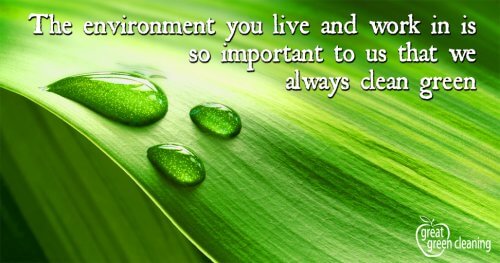Green Solutions
While some companies boast “Green Cleaning” as a feature, looking at the MSDS often reveals a slew of chemicals and fragrances. Great Green only uses products that meet our strict standards, to ensure they are effective and safe.
Great Green Solutions are:
- Non-toxic
- Non-reactive
- Hypoallergenic
- Non-carcinogenic
- Readily biodegradable
- Derived from renewable resources
- Safe to use, store and dispose of
- Readily biodegradable
- Derived from renewable resources
- Safe to use, store and dispose of
Great Green Solutions do not contain:
|
|
|
Comprised of plant-based materials, Great Green Solutions contain alcohols, fatty acids, esters, waxes, saponifiers, chelators, enzymes and other fractions from soy, corn, palm kernel, peanut, walnut, safflower, sunflower, Canola and cotton seed
These products consist of long-chain molecules; one end likes water, and is called hydrophilic, the other end likes oil and dislikes water, and is called hydrophobic. When these surfactants are placed in water, the hydrophobic ends attract each other, and repel water, and arrange themselves into a spherical structure with the hydrophobic ends inside the sphere at its nucleus, and the hydrophilic ends on the outer surface of the sphere. This sphere is called a micelle.
The hydrophobic ends begin to orient themselves on the surface of the soil lifting it from the cleaning surface to become part of a micelle, thus cleaning the surface. When combined with water, micelles break water’s surface tension resulting in “super wet” water. That same action allows the micelles to penetrate organic soils and to hold them in liquid suspension. In effect, the micelle cleaning action is unique and can only be related to the effect of an atomic explosion where random interaction of the particles loosens the soil. Micelles enable us to clean soils without damaging the cleaning surface.
And for those of you who are interested in reading more about our cleaning chemistry and how and why it works, read on:
The basis for our cleaning chemistries are colloidal solutions comprised of plant-based non-ionic surfactants that create unique hydrocarbon release agents that can tolerate tremendous soil loads. Our feature product is so powerful that crude oil will be completely lifted from the cleaning surface by only a small amount without causing an emulsion or damage to the cleaning surface. Powerful micelle cleaning action causes long chain hydrocarbon soils to virtually repel from the cleaning surface so that soils can be rinsed away with water.
Airport runways were cleaned using a 5% solution of Concrete Cleaner that was brushed on and rinsed with a pressure washer without damaging the concrete or paint.
What is a Surfactant?
A surfactant (surface-active agents) is a compound that has two groups present in the molecule:
- One being hydrophobic in nature which means water-hating or oil-liking
- One being hydrophilic in nature which means water-liking.
When you have a surfactant with two groups present, you have a chemical compound that has surface-active properties or the ability to affect the interfacial relationship between two dissimilar substances such as oil and water.
The development of new surfactants has brought aqueous cleaning into a new generation. New technology aqueous cleaners clean by subverting the soil. A non-emulsifying surfactant is designed to have a higher affinity for the substrate than the soil does. The surfactant thus “lifts” the soil from the part or surface without chemically reacting with it. For example, a non-emulsifying cleaner works well in spray applications. If a settling tank and oil skimmer are added to the system, soils can be removed and the cleaning solution can be reused, sometimes indefinitely, without recontaminating parts.
What is a Colloid?
A colloid, or colloidal dispersion, is a form of matter intermediate between a true solution (like salt dissolved in water) and a mixture or suspension (Italian salad dressing right after you shake it). Further research revealed that colloids have minute particles called micelles. When combined with water, micelles break water’s surface tension (the property that keeps water droplets round), resulting in “super wet” water. That same action allows the micelles to penetrate grease, oil and related organic soils and to hold them in liquid suspension. In effect, the micelle cleaning action is unique and can only be related to the effect of an atomic explosion where random interaction of the particles loosens the soil.
What is a Micelle?
The surfactants consist of long molecules with two very different types of ends. One end likes water, and is called hydrophilic, the other end likes oil and dislikes water, and is called hydrophobic. When these surfactants are placed in water, the hydrophobic ends attract each other, and repel water, and arrange themselves into a spherical structure with the hydrophobic ends inside the sphere, and the hydrophilic ends on the outer surface of the sphere.
It has been demonstrated that substances such as petroleum compounds, waxes, the more complex alcohols, oil soluble dyes and other substances, which are insoluble in dilute detergent solutions will dissolve in solutions that contain these colloid particles called micelles.
In laboratory tests the dyne/centimeter surface tension of tap water had been halved by the adding of as little as 1/3250th part of the cleaning soluttion. This may serve to explain why the invention of the basic cleaning solution allows us to constitute so many solutions from one product that can have the properties of a soap, a detergent, a solvent or other cleaner, and yet be none of these in itself, and to do so with so nearly a perfect safety factor.
What about cleaning?
Cleaning is mostly about cleaning different types of hydrophobic (or oily) soils. Why? Because hydrophilic, or water-liking, soils are usually easily rinsed off with water. Micelles enable us to dissolve hydrophobic chemistries into water.
The tails of the surfactant like the oil soils as well as they do each other, and begin to orient themselves on the surface of the oily soil as shown in the diagram below. Eventually that small part of the soil lifts off of the cleaning surface and becomes part of a micelle, thus cleaning the surface.
Two important features are its reusability and its poor emulsion formation. These two features actually have one single cause: the hydrophobic tails readily “let go” of oils, which then float to the surface of the water where they can be removed. Soils being cleaned are quickly incorporated into micelle structures.
Typically, aqueous cleaners are made up of a number of different ingredients including builders, surfactants, inhibitors and chelators. Most cleaners come with a long list of ingredients, many of which you may not need for most cleaning applications. These extra ingredients may cause you extra problems, especially in wastewater treatment.
The following outlines some common types of additives along with an explanation of what they do and the advantages and disadvantages of each:
- Builders: A builder is the basic ingredient of most aqueous cleaners. The most common builders are sodium hydroxide, potassium hydroxide and sodium silicates. All of these are alkalines and all are slimy and hard to rinse. Remember that proper rinsing is the most important step in aqueous cleaning.
- Inhibitors: Inhibitors are used to reduce the effects of highly alkaline or acidic cleaners on sensitive substrates. Inhibitors are also used to prevent rusting or oxidation of parts after cleaning. Chromates and silicates are commonly used pH inhibitors, but chromates have obvious environmental disadvantages. Hydroxides and silicates are commonly used to prevent rust. Inhibitors may make rinsing more difficult.
- Chelating Agents: Chelators are designed to keep metal ions in solution so that they will not migrate to adjoining surfaces.
- Sequestering Agents: Many alkaline cleaners are sensitive to the condition of incoming process water. Sequestering agents are used to ‘capture’ hard water ions such as calcium and magnesium, thus allowing the cleaner to work at maximum efficiency.
- Saponification: Highly alkaline cleaners can convert insoluble fatty soils to water soluble soaps. This will keep the soils in solution and the additional soap may aid cleaning, however it also causes disposal problems. Soaps created by saponification may cause a foaming problem in spray or ultrasonic applications.
- Emulsifiers: Emulsifiers take oils into solution and keep them from re-contaminating parts. This is useful in an immersion tank, but the more parts you clean, the dirtier the water gets until the bath becomes useless, requiring disposal. Before disposal, the emulsion must be “cracked” or ultra-filtered to remove the oils. Cracking requires either heat or acid plus time and money and then the bath must be refilled.
What about pH?
The effect of pH measurement (hydrogen v. hydroxil ions) in the aqueous products is of lesser importance because the products do not rely upon pH for cleaning, but rather on the unique properties of colloidal micelles which are formed almost independently of their solution pH. Salt-based chemistries such as Caustic Soda must rely on higher alkaline reserve numbers to achieve cleaning results. The natural pH of the surfactants, fatty acids and saponifers used are in the mid-alkalinity range and are not typically changed artificially. The alkaline reserve numbers for the products (measurement of ability to resist change to acid) are typically very low.
What are Dispersants? Solubilizer v. Emulsifier
A solubilizer provides certain important advantages when compared to traditional dispersants and emulsifiers.
In the process of oil spill clean up, the use of dispersants to disperse crude oils and oil derivatives may include other petroleum solvents and certain aqueous cleaning surfactants which serve to separate oil molecules and aid clean up. The task of separating oil molecules is made more difficult if an emulsion is formed.
In the following discussion, the term solubilizer will refer to a water miscible solvent that thins oil down to molecular sized particles and keeps them separated without reacting with the molecular structure of oil. The term dispersant will refer to any chemistry that serves the purpose of separating oil molecules regardless to what magnitude. And, emulsifiers will be referred to as chemicals which cause a colloidal suspension of oil in water that is generally irreversible and makes the separation or recapture of the oil molecule or coagulation of oil molecules apart from water practically impossible.
Solubilizers:
- Cause homogenous mixture (evenly blended into small droplets) of two or more miscible substances which do not interact with each other to form different chemistries
- Cause subdivision down to molecular magnitude
- Cause a solution of different chemicals that do not settle into different layers or apart from each other
- Do not require a fixed proportion of oil and solubilizer to cause separation
Emulsifiers:
- Are a precise relationship of oil, water and solvent
- Are generally irreversible in practical short term applications, such as a few hours or a couple days in a natural environment
- Lock up the entire petroleum hydrocarbon which then is unavailable for ready biodegradation by available bio-organisms and natural environmental processes
- Prevent the separation of petroleum hydrocarbons, which depletes available oxygen for natural organisms
- Are colloidal suspensions which encapsulate small droplets of petroleum hydrocarbons
Effectively solubilizers simply act to separate oil molecules into fine droplets, while emulsifiers act to encapsulate the oil molecule in a colloidal suspension which then hampers oil water separation for clean-up.
Historically, dispersants have been used to simply separate or thin oil spills so that they were more manageable and to recover the oil or oily sludge in the case of degraded crude. It was not important until very recent years whether the dispersant was toxic itself, but only that the oil was recoverable from ocean surfaces, boats, beach surfaces and marine animals. Dispersants were largely based upon straight solvent technologies and included aliphatic alcohols, petroleum distillates, terpenes and glycol ethers, all of which are now known to be toxic and/or carcinogenic. However, they are able to effectively thin various types of crude oils and even blended oils for recovery as long as the ocean surface was relatively calm.
As much as 85% of these dispersants would end up contaminating the ocean environment, including the volatiles they released into the air. In the case of a large mat of vicious crude floating over miles of ocean, spraying dispersant becomes less effective as oil ages in the water column and will generally from emulsions or characteristic mousse (diagram of chocolate mousse). At this point, oil in emulsion is extremely difficult to skim, pump or separate because it has become a colloidal suspension or approximately 80% water. Emulsions prevent ready biodegradation because the oily soil is locked into colloidal suspension and ready access to constituent molecules of carbon, hydrogen and elemental metals are blocked by powerful solvating bonds. Unless opposite conditions exist that first formed the colloidal suspension or emulsion, they will persist for indefinite periods of time. And, though the water phase emulsion may be diluted further, the colloidal suspension does not necessarily revert to coagulation of oil molecules so that they may be recovered by mechanical means or environmentally degraded by wave action and indigenous microorganisms.
Since the advent of organic solvents and aqueous cleaners and degreaser surfactants in the 1980’s onward, dispersants have increasingly relied on less environmentally invasive chemicals which readily biodegrade and, in many cases, work adequately as dispersants; that is they thin the oily mess. However, as with many traditional solvents, the new surfactants cause ready emulsions with oil once introduced to the water surface. While historically this was not a problem when environmental concerns were less important, simply thinning oil into an emulsion without improving the chances of biodegradation are no longer enough. Now total recovery of the petroleum hydrocarbon is the prevailing popular mandate.
About the Solvents…
The Safety Solvents are non-polar plant-based solvents which provide the same or higher performance characteristics of traditional halogenated or chlorinated solvents with few or none of the disadvantages. Safety Solvents include solvents that are water miscible and non-miscible and 100% evaporative and non-evaporative with Kauri Butinal (KB) values ranging from 150 to over 1000.
The Safety Solvents do not compromise on their performance by easily exceeding the highest values available for chlorinated solvents such as 1,1,1-Trichloroethane, Xylene or Methyl Ethyl Ketone (MEK). Generally, Safety Solvents are non-reactive with cleaning surfaces including elastomerics such as viton, butyl, nylon, acrylics, HDPE/LDPE, styrenes, urethanes, vinyls and most inorganic paints and coatings.
Safety Solvents are derived from alcohols and esters of soy, corn, rice, palm, cottonseed, linseed, safflower, sunflower, Jojoba soil, Jatropha, mustard, walnut and almond oils which are all readily biodegradable and non-toxic.
Why we don’t use…
Petroleum Distillates: Petroleum is a non-renewable resource. The extraction and refining of petroleum causes more environmental harm. Some petroleum-based solvents such as petroleum distillates are central nervous system depressants, and can also affect the liver and kidneys. Petroleum distillates including fuels such as gasoline, kerosene, diesel fuel, and heating oil as well as lubricating oils such as mineral oil, hexane and WD-40.
Glycol Ethers: Glycol Ethers are Phenolic compounds sometimes used in cleaners as a germicide and are extremely hazardous substances. Not only are they toxic, volatile and corrosive, but also they can be harmful to humans. Glycol Ethers are suspected carcinogens with exposure via inhalation and/or dermal absorption. Glycol ethers, such as ethylene glycol, cellosolve, carbitol and butoxy ethanol, are used in cleaners and degreasers for dissolving oil, wax and resin. Some are more toxic than others and can cause symptoms ranging from headaches, blurred vision and respirator irritation to bone marrow and reproductive health damage.
Terpenes: Terpenes are systemically toxic. They are generally associated with characteristic fragrances. In fact, most essential oils are mostly terpenes. Examples include menthol, citronellal, d-limonene, and pine-sol.
Silicones: Many polymers made up of alternating oxygen and silicon atoms combined with other organic groups. Silicone can be an oil, grease, gel or plastic, but all forms are resistant to heat, water and will not conduct electricity. It is used for a huge number of applications in industry including lubricants, paints, adhesives, and coolants.
Builders: Builders enhance or maintain the cleaning efficiency of the surfactant. The primary function of builders is to reduce water hardness. This is done either by sequestration or chelation (holding hardness minerals in solution), by precipitation (forming an insoluble substance), or by ion exchange (trading electrically charged particles). Complex phosphates and sodium citrate are common sequestering builders. Sodium carbonate and sodium silicate are precipitating builders. Sodium aluminosilicate (zeolite) is an ion exchange builder. Builders can also supply and maintain alkalinity, which assists cleaning, especially of acid soils; help keep removed soil from re-depositing during washing; and emulsify oily and greasy soils.
Borates: Borates are toxic and come in many different forms such as borax and are used to produce laundry detergents, household or industrial cleaners and personal care products. In these applications, borates serve as builders for stain removal and bleaching, stabilize enzymes, provide alkaline buffering, soften water and boost surfactant performance.
Metasilicates: A builder used to maintain very high pH.
Reagents: A cleaning product that works by chemically reacting with the soil, rather that as a release agent or a solvent. Caustic is an example, as is bleach, and some aldehydes. Reagents clean by degrading the cleaning surface.
Chlorine: The gas chlorine, chlorine dioxide or other chlorine containing compounds used as disinfectants. Chlorine bleach is toxic and often used in cleaners to disinfect and brighten surfaces, but will damage the cleaning surface and possess a hazard to workers. When sodiumhypochlorite, the active ingredient in chlorine bleach, is released into the environment, it may react with other elements and create toxic compounds. Chlorine is not biodegradable and can kill microorganisms in wastewater treatment plants and waterways.
Ammoniates: Compounds based on ammonia.
Aldehydes: Any of a class of highly reactive chemical compounds; used in making resins and dyes and organic acids. Aldehydes are toxic and are generally volatile (evaporative) and have strong odors.
Caustics: Materials such as caustic lye and metasilicates that create very alkaline conditions, and whose primary mode of cleaning is through their very high pH. Caustics are toxic and very harsh on materials and generally result in excessive wear.
Volatile Organic Compounds (VOCs): One of the biggest health hazards today is indoor air pollution. In some cases, air inside a building can be as much as 100 times more polluted than outside. If you have ever walked into a building and started coughing from the distinct odor of cleaners, it is likely the volatile organic compounds (VOCs) that are triggering your reaction. VOCS are a class of substances that evaporate easily and react in the atmosphere with sunlight and heat creating an unhealthy breathing environment. Millions of tons of VOCs are released into the air. The USEPA has found that over 900 different VOCs can be found in indoor air alone, from sources such as industrial and institutional cleaners as well as “off-gassing” from furniture, carpeting and paints. Exposure to high levels of VOCs can cause eye irritation, nausea, vomiting, headaches and/or impaired memory. VOCs present in some cleaners include formaldehyde and benzene, known or suspected carcinogens, and toluene, a factor in central nervous system dysfunction. D-Limonene and D-Pinene, although plant-based, are used in some cleaners yet they are also VOCs.
Phosphates: Cleaners may also contain phosphates, which serve as detergent builders and chelates. Although phosphate is a nutrient for aquatic plants, it can cause an overgrowth of algae when too much is present in the ecosystem. These algae “blooms” block the sunlight that aquatic plants need for photosynthesis activity, and delete the water of oxygen needed by aquatic life.
In addition to our Great Green Solutions we also use Bar Keepers friend as a scouring agent:
Since 1882, Bar Keepers Friend® has been the “Can Do Cleanser.” Available in either powder or liquid, Bar Keepers Friend has millions of loyal users who give credence to the motto, “Once Tried, Always Used.” Bar Keepers Friend is a premium all-purpose cleanser that works without chlorine bleach for everyday cleaning and tough stains including lime and rust.
Search the Internet using the words “Bar Keepers Friend”, “clean” and almost any surfaces such as “tile”, “stainless steel” or “solid surface counters” and find testimonials such as this posting from Cincinnati, Ohio:
“We have been using it on our glass cooktop and it works great. We were making blueberry syrup last night and had a boil over. It worked beautifully to get the gunk off. I use it in the sinks, the tub, even dump some in the toilet if I run out of toilet cleaner. We love the stuff!”





